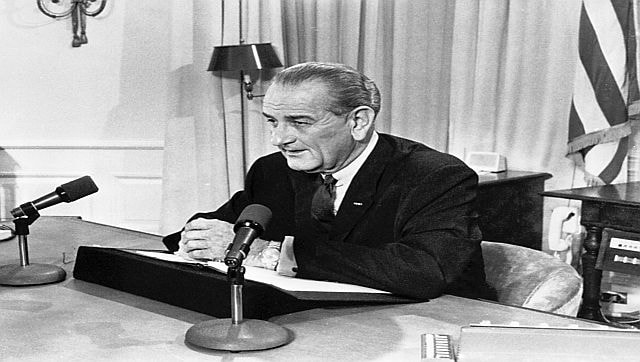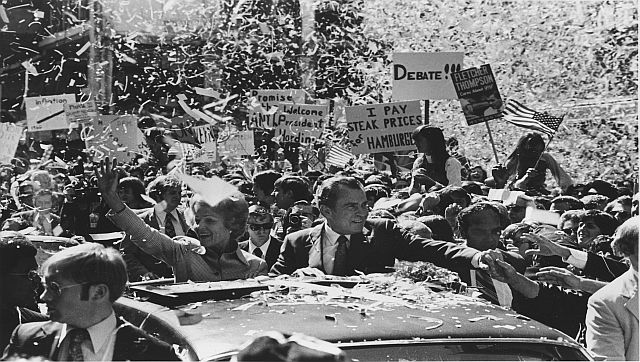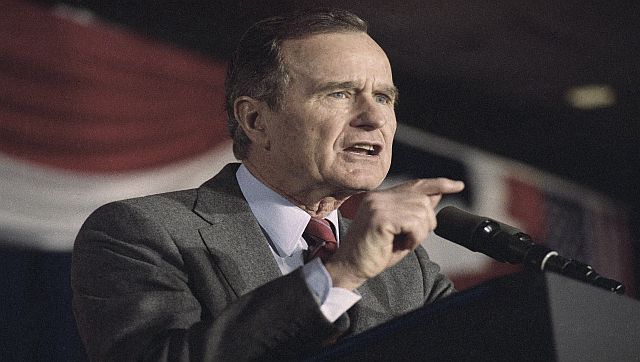Washington: No president wants to give up the power and prestige that comes with the office after only one term, and Joe Biden is no exception. He’s pushing forward even though polls show a majority of Americans don’t want to see him run again.
We went back to look at when modern presidents announced their decisions to seek a second term, what their Gallup approval ratings were at the time and how things turned out for them.
One theme: Primary battles are a sign of whether a president will win reelection. That’s good news for Biden, who appears to have avoided any significant challengers.
Harry Truman
He was vice president when President Franklin Delano Roosevelt died in 1945, near the end of World War II. Truman decided to run for a full term of his own, and he announced his candidacy on 8 March, 1948.
He had an approval rating of 53 per cent in a poll conducted two months earlier. Truman was expected to lose the general election to Thomas Dewey, a Republican, but he pulled off a narrow victory.
Truman announced on 29 March, 1952, that he would not seek a second full term after losing in the New Hampshire primary to Senator Estes Kefauver of Tennessee. His approval rating had sunk to 22 per cent amid economic trouble and the Korean War.
Impact Shorts
More ShortsDwight Eisenhower
Eisenhower, a Republican, had an approval rating of 75 per cent shortly before he announced his reelection campaign on 29 February, 1956. He had suffered a heart attack months earlier at age 64, leading to questions over whether he would run.
As the former supreme allied commander during World War II, Eisenhower convinced Americans that he was the right leader on the world stage. He defeated Democratic candidate Adlai Stevenson.
John F Kennedy
Kennedy was assassinated in 1963, before he had a chance to run for a second term.
Lyndon B Johnson
Johnson was vice president at the time of Kennedy’s death, and he swiftly ran for his first full term in 1964, winning a landslide victory over Republican Barry Goldwater. However, the Democrat’s popularity slipped badly over the Vietnam War and domestic turmoil.
[caption id=“attachment_12537322” align=“alignnone” width=“640”] Lyndon B Johnson shocked the country by announcing on 31 March, 1968, that he would not seek a second term. His approval rating was only 36 per cent that month. File image/AP[/caption]
Lyndon B Johnson shocked the country by announcing on 31 March, 1968, that he would not seek a second term. His approval rating was only 36 per cent that month. File image/AP[/caption]
It became clear that Johnson was at risk of losing his party’s nomination in 1968 after Eugene McCarthy’s strong showing in the New Hampshire primary. Soon after, Johnson shocked the country by announcing on 31 March, 1968, that he would not seek a second term. His approval rating was only 36 per cent that month.
Richard Nixon
Nixon had an approval rating of 50 per cent when he announced his reelection campaign on 7 January, 1972. The Watergate break-in at the Democratic National Committee headquarters occurred that summer, but the scandal didn’t gain enough momentum to drag him down.
[caption id=“attachment_12537242” align=“alignnone” width=“640”] Richard Nixon had an approval rating of 50 per cent when he announced his reelection campaign on 7 January, 1972. File image/AP[/caption]
Richard Nixon had an approval rating of 50 per cent when he announced his reelection campaign on 7 January, 1972. File image/AP[/caption]
Nixon, a Republican, defeated George McGovern, a Democrat, in a landslide. However, he would not finish his second term, resigning in 1974 after revelations about Watergate caught up with him.
Gerald Ford
Ford, a Republican, became president when Nixon stepped down, and he announced that he would run for a full term of his own on 8 July, 1975. He had a 52 per cent approval rating the month before.
Also Read: How much did US president Joe Biden and First Lady Jill earn in 2022?
He faced discontent over inflation and controversy from his decision to pardon Nixon, and he lost the election to Jimmy Carter, a Democrat.
Jimmy Carter
Carter announced his reelection campaign on 4 December, 1979. His approval rating had just hit 51 per cent. However, the American people had grown weary of inflation, an energy crisis and a hostage crisis in Iran. Carter was wounded by a primary challenge from Senator Ted Kennedy, and he was ultimately defeated by Ronald Reagan, a Republican.
Ronald Reagan
Reagan announced his reelection bid on 29 January, 1984. His approval rating was 52 per cent that month. Despite concerns about his age — he was 73 and the oldest president in history at the time — Reagan handily defeated Walter Mondale, a Democrat.
George H W Bush
Bush’s popularity skyrocketed after the Gulf War, when US forces pushed Iraq out of Kuwait. However, his approval rating had subsided to 65 per cent by the time he announced his reelection campaign on 11 October, 1991.
[caption id=“attachment_12537302” align=“alignnone” width=“640”] George HW Bush’s popularity skyrocketed after the Gulf War, when US forces pushed Iraq out of Kuwait. File image/AP[/caption]
George HW Bush’s popularity skyrocketed after the Gulf War, when US forces pushed Iraq out of Kuwait. File image/AP[/caption]
Pat Buchanan challenged Bush in the Republican primary. Although Bush won the nomination, his shot at a second term dimmed amid an economic downturn. He ultimately lost to Bill Clinton, a Democrat.
Bill Clinton
Clinton’s approval rating was 47 per cent when he announced that he would run for reelection on 14 April, 1995. Democrats had suffered a wipeout midterm election in 1994, leading some to question whether Clinton would be a one-term president. But he rebounded with the help of a growing economy, and he defeated Bob Dole, a Republican.
George W Bush
The 11 September attacks of 2001 led Bush, a Republican, to invade Afghanistan, followed by another war in Iraq. One month after US forces entered Baghdad, Bush announced he would run for reelection on 16 May 2003. His approval rating was 69 per cent that month. He defeated John Kerry, a Democrat.
Barack Obama
Obama, a Democrat, had a 48 per cent approval rating when he announced his reelection campaign on 4 April, 2011. He struggled to convince Americans that the economy was improving after the financial collapse and subsequent recession, but he ultimately defeated Mitt Romney, a Republican.
Donald Trump
Trump , a Republican, announced that he would run for reelection on 18 June, 2019. The previous month, his approval rating was 41 per cent. He was impeached for the first time at the end of the year, and then the coronavirus pandemic stalled the economy. Joe Biden, a Democrat, defeated Trump, who tried to prevent the peaceful transfer of power.
[caption id=“attachment_12537252” align=“alignnone” width=“640”] Donald Trump, a Republican, announced that he would run for reelection on 18 June, 2019. AP[/caption]
Donald Trump, a Republican, announced that he would run for reelection on 18 June, 2019. AP[/caption]
Joe Biden
Biden announced his reelection campaign on 25 April. His approval rating was 40 per cent the previous month. Biden would be 86 at the end of a second term, leading to fears that he’s too old to keep such a demanding job.
Also Read: What’s the ‘Dark Brandon’ meme that Joe Biden is using for his 2024 re-election campaign?However, Biden has not drawn any significant primary challengers. The only Democrats running are Marianne Williamson and Robert F Kennedy Jr. Meanwhile, Trump is leading in Republican primary polls as he seeks the party’s nomination, raising the potential for a rematch with Biden.
Read all the Latest News , Trending News , Cricket News , Bollywood News , India News and Entertainment News here. Follow us on Facebook , Twitter and Instagram .
)